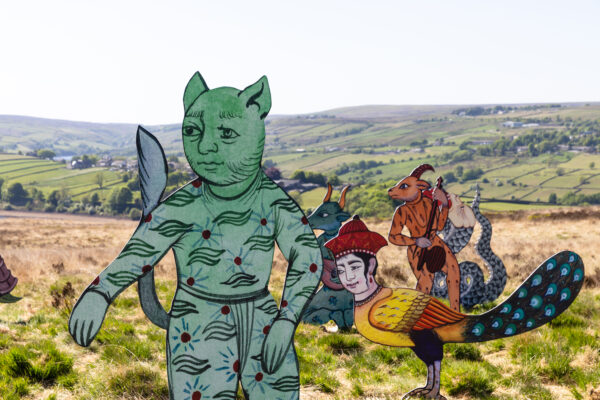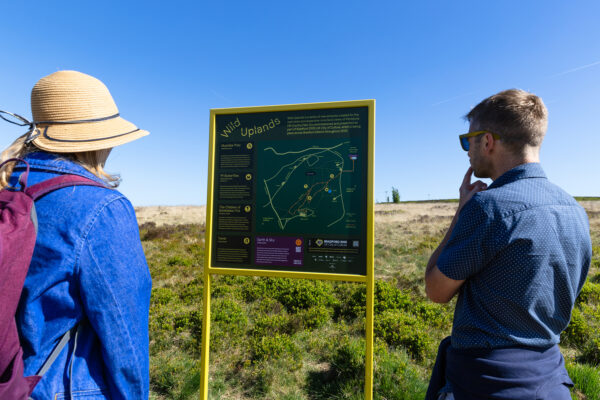
Wild Uplands: Audio Description
Listen to an Audio Described introduction to the four Wild Uplands sculptures.
Wild Uplands was a series of new artworks created for Bradford 2025.
Shanaz Gulzar, Creative Director of Bradford 2025 and the curator of Wild Uplands, invited four leading artists – Monira Al Qadiri, Meherunnisa Asad with Studio Lél, Vanessa da Silva and Steve Messam – to create new artworks for the vast skies and expansive moorland views of Penistone Hill Country Park.
On this page you can find audio-described introductions to the work created by each of these four artists for Wild Uplands.
99 Butterflies
99 Butterflies is inspired by Palestinian poet Mahmoud Darwish’s haunting question: “Where will we go after the last frontiers? Where will the birds fly after the last sky?”
Listen to an audio described introduction to 99 Butterflies.
Transcription - 99 Butterflies
Hi, Tom here, from Bradford 2025’s community trainee audio description team. I’ll be describing 99 Butterflies – by Meherunnisa Asad and Studio Lél.
As we approach the gently sloping moorland trail, an almost secret spot reveals itself by a peaceful dip in the land where a natural amphitheatre of grass and heather holds a small, shallow pond.
Guiding us to the water’s edge, lies a flutter of butterfly sculptures, about 60 of them, scattered down the trail. They appear as if they have landed naturally to rest and they span wider as they reach the water, subtly leading us down amongst them in the hideaway.
The butterflies are crafted from marble stone, cold and firm to touch, and smooth to run a finger along.They are formed lying with outspread wings that are pieced together with intricate segments, like a complex jigsaw, and where the pieces join, we can feel the cracks, some more pronounced than others.
Each one is unique in size, with wingspans ranging from the size of a chess board to the size of a family dining table.
They all proudly display their own unique pattern. Some of them show-off ornate floral designs intertwined with silhouettes of hummingbirds and abstract organic shapes. Whilst others hold symmetrical segments of grainy and speckled textures, looking like something you might find in the wild.
Whilst each one has its own identity, they are unified by their earthy palette of rose pink and terracotta, with faint splashes of pale cream and sky blue – their decorative motifs in ruby red create contrast. The butterflies stand-out but feel at home in the landscape around them.
We’re invited to move around the area and get different perspectives of the collection as a whole and of each unique design. Some are tilted by the uneven terrain, and some are nestled slightly in the grass. If we perched on the bench at the top of the hill, we could take in the whole scene, with the people moving through and around them.
What a treat to encounter them resting here, before they flutter off in the wild moorland breeze.
Muamba Posy
Muamba Posy is a series of interactive sculptures that reflect on the ever-changing cycles of nature on Penistone Hill, where life has adapted and transformed over time.
Listen to an audio described introduction to Muamba Posy.
Transcription - Muamba Posy
Hi,
It’s Owen here, from Bradford 2025’s community trainee audio description team. I’ll be describing Muamba Posy by Vanessa Da Silva.
Three structures stand on a fairly flat bit of the lower part of the moor, growing out of the grass just off the path, arranged as if at the three points of a rough triangle. Each is almost as tall as a giraffe. They’re made of metal and fibreglass, so they either ring or knock depending on where you tap them. The ground is uneven underfoot but it’s possible to walk all the way around and between them. As a collection, they appear as vibrant scribbles of colour against the greens and browns of the landscape and the blue – or more usually grey – of the sky. From a distance they look a little like giant versions of those school science lesson DNA molecule kits, or maybe three strange alien beings that have just beamed down and are loping across the moor.
One structure, in mustard yellow, fleshy pink and plummy-purple, has two blobbly circular pieces at the top like a pair of comedy glasses, above an upright oval. Below this is a section like a closed umbrella, with four yellow gourds laid on their sides in a points-of-the-compass arrangement at the base.
A second structure, in a riot of apple green, sky-blue, blackcurrant purple and citrus orange, connects five balls of various shapes and sizes – one of them like a descending water droplet – with loosely knotted squiggles.
The remaining structure looks like two flowers reaching for the sky on long stems. The petals – four on one flower, three on the other – are each a vibrant red, yellow, pink, blue, purple, green and orange. The centres, in bottle-green and fuchsia pink, look like closed tulips. The stalks are plum purple and banana yellow, emerging from two large bulbs lying on their sides at the base, one lipstick red and the other powder blue.
The contrast with their natural surroundings makes all three structures pop amongst the moorland.
The Children of Smokeless Fire
The Children of Smokeless Fire is a work of mystery and magic with two distinct inspirations: the famous ‘Cottingley Fairies’, created by two Bradford girls in 1917, and the Djinns, mythical beings depicted in a 13th-century Islamic manuscript by Zakariya al-Qazwini.
Listen to an audio described introduction to The Children of Smokeless Fire.
Transcription - The Children of Smokeless Fire
Hi,
It’s Tom here, from Bradford 2025’s community trainee audio description team. I’ll be describing The Children of Smokeless Fire – by Monira Al Qadiri.
As we wander across an exposed side of the moor, the landscape stretches out with rolling hills, farmers’ fields and Lower Laithe reservoir nestled in the valley. In the foreground is a collection of mythical creatures: Sixteen life-size, 2-dimensional figures with hand painted designs, each cut from steel. They are frozen still, as if captured from a dream, and span across the hillside over a distance the length of a tennis court. While they alll face towards us, some look left, and others look right. They’re spaced evenly across the space, most individually, but some in pairs.
Among them are some curious creatures, their anatomies bend reality, partially resembling familiar animals but none are quite what they seem. They are mythical hybrids, merging traits from multiple creatures into new forms, some taking on the heads or bodies of humans.
Two humanoid musicians, with goat’s heads, pluck at ancient stringed instruments. Both wear hand painted, floral patterned body suits – not unlike pyjamas. One wears emerald green, the other a deep orange.
There are several serpents, one of them breathes fire through its wide mouth with sharp fangs, while another wraps around a human figure, staring into its eyes with its own human head.
Some of them resemble more familiar mythical creatures, like a centaur with the body of a horse blending into the upper half of a human figure wielding a sword above their head.
Each figure is made from a thin sheet of steel, indestructible against the elements, but not free from a gentle wobble in the wind. Tap one with a knuckle and it will play out a resonant ringing tone.
From behind, the figures show their construction, just their silhouettes in the metallic grey of the raw material. They’re bolted into steel anchors buried beneath the ground, secured with heavy-duty nuts and screws. A few of them are raised on sturdy square poles to meet the level of the others. The contrast between front and back invites us to move around them, on the knobbly uneven shrubland, and as we do each figure begins to almost vanish from the side.
Moving away from them, and looking back, their steel, mirrored reverse side reflects their surroundings, making us wonder if we have been part of the dream.
Tower
Tower explores the building blocks of the Penistone Hill landscape and their relationship to the building of Bradford. The 10m sculpture is clad in the raw fleece of Derbyshire Gritstone and Lonk, two sheep breeds common to the local area.
Listen to an audio described introduction to the Tower.
Transcription - Tower
Hi, Ric here, from Bradford 2025’s community trainee audio description team. I’ll be describing Tower by Steve Messam.
Based in County Durham, his work engages audiences by interrupting familiar settings with bold, ephemeral art installations.
His practice explores the stories within rural and urban landscapes. Drawing inspiration from geology, cultural histories, and farming methods, Messam creates installations that bring a sense of place to life.
Here we meet a tower that is half a cricket pitch tall, reminiscent of a distorted fluffy Arc De Triomphe, or part of Stonehenge if someone gave it a warm coat. The structure has been stacked as though a giant has been distracted halfway through playing Jenga with woolly rectangular weetabix.
The sculpture is inspired and created by stone block forms drawn from the quarry of Penistone Hill country park and their relationship to the building of Bradford. These blocks are clad in the fleece of local sheep breeds, namely Derbyshire Gritstone and Lonk.
The rawness of the wool is evident from the remnants of brighter colours amongst the natural cream. A splat of fluorescent yellow here, a dab of lurid purple there, denoting where the farmer has marked his flock.
This fleece cladding is inspired both by the role played by sheep in physically shaping and maintaining the surrounding landscape, and by the importance of wool in the industrial history of Bradford – not for nothing was it nicknamed the ‘Wool Capital of the World’.
The high arch through the tower frames views across the surrounding landscape and is like a raised finger to its surrounding. It is narrow enough to reach both arms out and touch the sides but is almost as tall as a telegraph pole, so there’s no danger of banging your head if you pass through the gap.
The structure cries out to be touched and it is hard to resist. This human intervention and moorland wind has already left tufts of wool catching in the surrounding foliage forming sheepy cobwebs all around the site of the sculpture.
